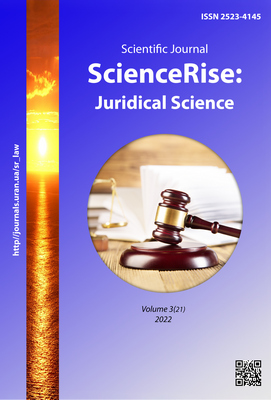Legal and ideological model of the formation of socio-legal consciousness of military servicemen as a component of social and legal support of the activities of the personnel of the national guard of Ukraine
DOI:
https://doi.org/10.15587/2523-4153.2022.265571Keywords:
legal ideological model, social and legal support, military personnelAbstract
The article is devoted to a comprehensive study of the social and legal support of the military personnel of the National Guard of Ukraine. During which it was found out that, according to the norms of the current legislation, social and legal support is an activity to create the necessary social and legal conditions for observing constitutional rights and freedoms, meeting the social needs and interests of military personnel in the course of preparing and performing combat missions; compliance with international humanitarian law; maintaining high discipline, organization and order.
Based on this, the author's vision of the factors, influencing the formation of the social and legal consciousness of military personnel during military service and performing tasks for their intended purpose, is formulated, and three levels of their implementation are defined: micro-level, medium level and macro-level.
The micro level includes: basic knowledge (obtained at school, higher educational institutions, higher military educational institutions); safety conditions in the performance of service and combat missions (norms of the current legislation); socio-cultural development (the degree of development of a serviceman in all spheres of human activity under the influence of changes in the dominant system of values).
Medium level – self-realization (realization of the potential of a serviceman through career achievements); qualification of the military team/chief (formed by the personal attitude of the team/chief to the legal norms of the current legislation and implemented by observing them).
Macro level – the mentality of society (way of thinking, general spiritual mood of society); state policy of Ukraine (the reaction of the state to specific problems of society (or groups in this society) is a fundamental guide to action for public authorities in accordance with laws and social customs).
Based on the results of the study, the author's position on the very legal-ideological model of the formation of the social and legal consciousness of military personnel as a component of social and legal support for the activities of the personnel of the National Guard of Ukraine and its levels is provided.
In order to increase the effectiveness of the functioning of the legal-ideological model for the formation of the social and legal consciousness of NGU military personnel, it is advisable: within the macro-level – the state leadership adhere to the implementation of social guarantees for military personnel and strengthen the propaganda of the authority of the "man in uniform" through the media; within the framework of the middle level – the local leadership independently make decisions on improving the quality potential of personnel, based on the specifics of the assigned tasks; within the framework of the micro level – during individual training, constantly inform the personnel about the latest changes in the current legislation and instill legal consciousness for the actions taken.
Attention is focused on the problematic issues that arise at the present stage of development of the state
References
- Yahupov, V. V. (2022). Moralno-psykholohichne zabezpechennia. Kyiv: Vydavnycho-polihrafichnyi tsentr «Kyivskyi universytet», 349.
- Kyrylenko, V. I. (Ed.) (2010). Pravova robota v Zbroinykh Sylakh Ukrainy. Kyiv: RVTs «Viiskovyi instytut», 408. Available at: https://hi.b-ok.global/book/3056851/1969fd
- Kobzar, A. O., Kopanytsia, O. V., Hrytsiuk, V. M. et. al.; Andresiuk, B. P. (Ed.) (2011). Vykhovna robota u Zbroinykh Sylakh Ukrainy. Chernivtsi: Misto, 334.
- Pravova propahanda. Ofitsiinyi sait dovidkovoi informatsii LIGA 360. Available at: https://ips.ligazakon.net/document/TS001514 Last accessed: 23.01.2022
- Shcherbina, O. M. (2007). Udoskonalennia zakonodavstva shchodo sotsialnoho zakhystu viiskovosluzhbovtsiv: suchasnyi stan ta perspektyvy. Pravo viiskovoi sfery, 2, 26–28.
- Boiovoho statutu mekhanizovanykh i tankovykh viisk Sukhoputnykh viisk Zbroinykh Syl Ukrainy Chastyna II (batalion, rota). Ukrainian Military Pajes. Available at: https://drive.google.com/file/d/1MEA8sqi1GpgwGJOgRkpSfeNbgrtmbxj9/view Last accessed: 23.01.2022
- Sparks, A. T. (2015). Political ideology and military service. Available at: https://scholarworks.iupui.edu/bitstream/handle/1805/10875/Drew%20Sparks%20Political%20Ideology%20and%20Military%20Service.pdf?sequence=1 Last accessed: 23.01.2022
- Freire, J. (2010). The Military and Political Intervention: Ideological Trends and Contemporary Contexts*. RCCS Annual Review, 2. doi: https://doi.org/10.4000/rccsar.227
- Human Rights of Armed Forces Personnel: Standards, Good Practices and Recommendations. Available at: https://www.osce.org/odihr/480152 Last accessed: 23.01.2022
- Human rights of members of the armed forces (2010). Strasbourg, 73. Available at: https://policehumanrightsresources.org/content/uploads/2016/06/CoE-Guidelines-on-Human-Rights-of-members-of-the-armed-forces.pdf?x96812 Last accessed: 23.01.2022
- Vashakmadze, M. (2018). Understanding Military Justice: A Practice Note. Geneva, 55. Available at: https://www.dcaf.ch/sites/default/files/publications/documents/Military-Justice_Prictice-Note_eng.pdf Last accessed: 23.01.2022
- Human rights awareness educations for general officers and flag officers. Available at: https://capstone.ndu.edu/Portals/83/Documents/Capstone/HumanRightsGOFO.pdf Last accessed: 23.01.2022
- Pro zatverdzhennia Polozhennia pro orhanizatsiiu roboty z osobovym skladom u Natsionalnii hvardii Ukrainy (2021). Nakaz Komanduvacha Natsionalnoi hvardii Ukrainy No. 515. 05.11.2021.
Downloads
Published
How to Cite
Issue
Section
License
Copyright (c) 2022 Anastasia Midina, Oksana Orel

This work is licensed under a Creative Commons Attribution 4.0 International License.
Our journal abides by the Creative Commons CC BY copyright rights and permissions for open access journals.
Authors, who are published in this journal, agree to the following conditions:
1. The authors reserve the right to authorship of the work and pass the first publication right of this work to the journal under the terms of a Creative Commons CC BY, which allows others to freely distribute the published research with the obligatory reference to the authors of the original work and the first publication of the work in this journal.
2. The authors have the right to conclude separate supplement agreements that relate to non-exclusive work distribution in the form in which it has been published by the journal (for example, to upload the work to the online storage of the journal or publish it as part of a monograph), provided that the reference to the first publication of the work in this journal is included.









